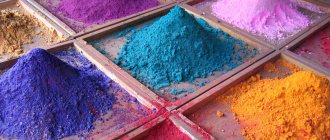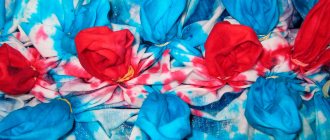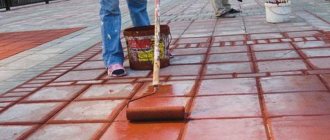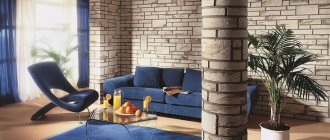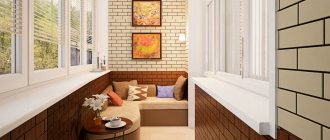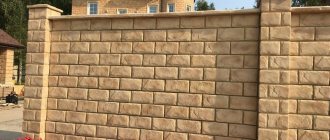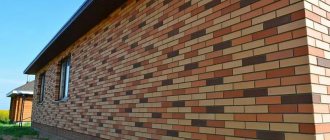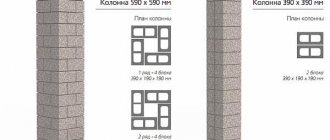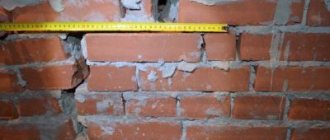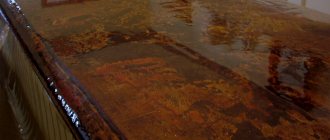Concrete structures can not only be gray and dull - in modern construction, stone is often painted in different colors and shades. Tinted curbs, paving slabs and other elements for finishing facades and street areas look much more interesting than their usual gray counterparts. To color concrete, you can use colored cement or pigment, and you can make a solution or paint the finished stone in the desired shade yourself.
Basic dyeing methods
You can make a design colored in two ways:
- Add pigment when mixing the solution. In this case, the paint will be distributed throughout the entire volume of the product, which means that even if chips and cracks occur, color transitions will not occur;
- The finished product can be painted if its surface is not subject to mechanical stress, in particular abrasion.
The concept of colored concrete does not mean a material that is superficially colored, but pigmented throughout its entire volume. This type is universal in use, suitable for the manufacture of paving slabs, wall panels and other structures and products that, during operation, retain their appearance even with surface abrasion.
What components of the cement mixture give additional color to concrete?
In the process of casting artificial stone with alternate replacement of various ingredients of the cement mixture (using only white cement), the following was revealed:
- Regular quartz sand gives concrete a beige tint.
- Shale ash gives concrete a yellow-beige hue.
- Microsilica (metakaolin MK-40) gives concrete a pink tint.
- In accordance with the color of the plasticizer used, the shade of the resulting stone also changes.
Conclusion: if you want to get a very light and delicate color, then you need to take into account these features of the components of the cement mixture. Moreover, the less water in the solution, the brighter the color of the stone.
Working with pigment
Three types of pigments help make concrete colored:
- Metal oxides;
- Pigments from minerals and mining products;
- Chemical complex compounds.
A special feature of working with any coloring components is the difficulty of choosing a shade: each base color can have a wide range from saturated to pale, and pigments can also be combined with each other.
Dyes for tinting concrete are dry powders that are dissolved in water. The intensity of their manifestation depends on several conditions:
- Type of binder used. To obtain a pure color solution, it is advisable to use colored cement or pure white - it will not give a gray tint to the background, unlike ordinary Portland cement.
- The amount of pigment and its quality determine the intensity of the color and the duration of its preservation. Different compositions require a special approach when diluting and carrying out concrete work (temperature, humidity).
- The quality of the main components of the concrete solution - cement, sand, coarse filler (crushed stone, colored glass can be added, there may be no major incidents at all). Their purity and basic parameters must comply with GOST 26633-2012;
- The amount of water affects the color intensity and strength of the finished stone, so you should not deviate from the technology and recipe. Excess liquid will make the mixture workable, but the products most likely will not last long, and the color will wash off quickly.
The technology used to produce colored concrete is no different from mixing a regular mortar, with the exception that pigment is added to the water.
At home, you cannot do without an autonomous concrete mixer for mixing components - only with its participation can you dissolve the paint and achieve its complete distribution throughout the entire volume.
How to make colored concrete:
- Pour 7-8 liters of water into the concrete mixer;
- Pour the pigment into the water according to the instructions;
- To impart plasticity to the solution in water, it is also necessary to dissolve a plasticizer. This must be a special agent that increases the elasticity of concrete. As for the use of soap and any detergents with surfactants, opinions on the advisability of their use are controversial. In industrial construction, the use of such a component is impossible and is not considered; in private practice, many craftsmen actively use surfactants;
- Now cement and sand are added to the solution in a ratio of 1:3 (it is convenient to measure in units, 4 buckets of dry substances will require 7-8 liters of water). At the same stage, a large filler is introduced.
The technology for mixing colored masonry mortar is presented in the video; the process for making concrete is similar.
After mixing is completed, the mass is placed in a mold, applied to the wall or laid, depending on the purpose of the solution.
Colored cement is also sold ready-made, mixed with pigment. In this case, the kneading is carried out using conventional technology.
Selection of paint and varnish material
Previously, it was easier to choose paint, since the assortment was scarce. There are many paints on store shelves today, but not all of them can be used on concrete. It all depends on the operating conditions. Having considered the features, advantages and disadvantages, you can choose what to paint your concrete floor, ceiling or walls.
Oil-based paints and varnishes
The products are made on an oil base. It has long been used for painting interior and exterior surfaces. However, due to the toxic composition due to solvents, it is better not to use it inside. Has a pungent odor. Advantages:
- Affordable price.
- Withstands the negative impact of the street, is not afraid of moisture and other atmospheric factors.
- A durable and beautiful coating is created.
- Oil-based paint can be susceptible to dust and dirt, but it is easy to clean with gentle products.
- Long service life.
- Good adhesion.
- Large selection of colors.
Flaws:
- Strong smell. Requires waiting for weathering before moving in.
- Toxicity.
- Long drying time, 24 hours or more.
- Has low elasticity, if the concrete cracks, the paint will tear.
- The color is unstable. The drying oil will turn yellow as it is used.
To conclude, oil paint for concrete walls is good if you need to repaint a storage area or other exterior surfaces. After all, it is cheap and practical. But it is better not to use it for work around the house or garage.
Water based paint
Water emulsion and dispersion are an excellent option for interior painting. It is water-based, so it has many advantages. There are no harmful substances in the composition. It can be used to paint concrete walls, ceilings and interior floors. There are façade paints for exterior use. The packaging indicates for what purposes the composition can be used.
Advantages:
- Environmentally friendly.
- Not afraid of moisture.
- Dries quickly.
- Has no smell.
- Easy to use.
- Paints can be sold in white and tinted by hand.
As for the disadvantages, the only thing we can note is the cost. It is low, but oil formulations are cheaper.
Acrylic paint
A universal option, it can be used to paint concrete ceilings, floors, walls inside and outside. It is based on acrylates, which give the composition special properties. The packaging indicates for what purposes it is used: “Ceiling”, “Facade”, “For walls”. Acrylic compositions are also used for artistic painting.
Advantages:
- Environmentally friendly.
- Not afraid of mechanical impact.
- Elastic.
- Vapor permeable, the walls will breathe without condensation.
- Has a stable color throughout its entire service life.
- Possibility of tinting.
- Long service life.
- Not afraid of moisture.
The downside is the cost. It is high. But if you consider the benefits, the price is justified. When choosing what to paint a concrete wall with, you can safely buy alkyd compounds.
Silicate based
It is also called glass paint, as it is based on liquid glass. Thanks to this, a durable film is created on the surface after painting, protecting the structure of the concrete surface. Suitable for indoor and outdoor surfaces.
Important! To find out the consumption of facade paint per 1m2, you need to look at the packaging. There are specific numbers there.
Advantages of silicate paints:
- Not afraid of chemical exposure.
- Has stable color.
- Strong and durable.
- Protected from fire.
- Not afraid of moisture.
- Resistant to biological factors (development of mold and other microorganisms).
- Very wear-resistant.
Their disadvantages are that they are expensive and contain toxic substances, so when working with them, it is important to take care of respiratory protection.
Advice! There is a rubber-based paint specifically for concrete surfaces. It is often used to paint concrete floors, as it creates a soft coating on the surface. It is elastic and not afraid of small cracks. She also perfectly tolerates all negative influences.
Impregnations for concrete
Painting walls requires preparation. Before the process, it is better to coat the surface with a special impregnation. This will preserve the surface from dirt, moisture and aggressive environments. The impregnation will penetrate the concrete structure and strengthen it. The compositions are made on an acrylic base, polyurethane or epoxy resins. In addition, preliminary application will reduce paint consumption. After all, concrete has a porous structure and absorbs liquids well.
After applying the impregnation, the wall will dry in a few hours (exact time on the packaging). After this, the wall, floor or ceiling will be ready for painting. The impregnation itself is transparent and may also have additional properties, for example, antiseptic. Having considered the features of paints, you can choose what to paint your concrete floor with.
Coloring
If the structure has already been created from gray cement, and you need to give it a shade, various coloring solutions will help. This method is suitable for surfaces that are not subject to intense abrasion. What paints to use:
- Epoxy enamel;
- Rubber paint;
- Acrylic paint;
- Polyurethane solutions;
- Alkyd-urethane enamels.
Epoxy and rubber paints are suitable for floors, which are able to maintain the integrity of the layer even with heavy traffic of people or cars. However, their service life does not exceed 5 years (rubber - 10 years).
Acrylic and polyurethane, as well as epoxy paints are available in a wide variety of colors and are suitable for application to walls and structures that are subject to minimal abrasion loads.
How to make colored concrete with your own hands using the coloring method:
- The base must be dust-free and strengthened with a primer (read the instructions for the paint; some solutions do not require priming);
- Apply paint to the dry surface with a roller or brush in 1-2 layers, depending on the desired color intensity.
Processing of finished structures
Effect of cement color on concrete color.
The second method of painting concrete involves treating already finished surfaces. It is usually used where physical impact is minimal, since the top layer quickly wears off and loses its decorative effect. This type of painting does not require large expenditures, gives an even and deep color, and makes the surface highly decorative. Pigments are added to ready-made impregnations, thanks to which they easily penetrate several millimeters into concrete.
In order for the painting to be of the highest quality, it is necessary to choose the right impregnation. Water is ineffective for this purpose, since the pigment quickly fades and is washed out. For cement, the most optimal are deeply penetrating water repellents, as well as varnishes and colorless primers. Mixing and applying them is quite simple, so you can do this kind of work yourself without involving specialists. When choosing pigments and impregnations, pay attention to the specified penetration depth and moisture resistance, because the durability of the coating depends on this.
So, surface painting consists of two stages: preparing the paint mixture and applying it to concrete. To prepare the mixture, you need to thoroughly dissolve the pigment powder in the carrier impregnation. Carriers are produced on the basis of drying oil, white spirit, acetone or water. For high-quality concrete processing, you should strictly adhere to the manufacturer's recommendations, otherwise the result may disappoint you. Apply the finished mixture with a roller, brush or spray, and it is advisable that the painting be done in two or three layers.
Summary
Colored concrete is a material from which you can create any structure or product for finishing walls, landscaping personal plots, sidewalk areas, etc. The advantages of pigmenting cement and concrete mortar over surface painting are obvious:
- Color durability;
- Uniform distribution of paint throughout the body of the product;
- Abrasion resistance throughout the entire life of the element.
True, the stability of the properties is determined by the quality of the pigment and the correct technology for preparing the concrete solution.
If it is not possible to make the product colored throughout its entire volume, coloring will come to the rescue - a wide selection of enamels will satisfy any needs in shades, but such a coating does not last long.
How to make dyes with your own hands
This video explains this issue in detail:
Or you can use the following recipe:
You can prepare the pigment for colored concrete yourself. For this you will need: lime, water, soap, lime dye and calcium chloride.
Preparation of pigment:
- Slaked lime is diluted in 5 liters of water, and the mixture is set aside.
- Dilute lime dye with water to obtain a liter of mixture. Calcium chloride is added to the coloring mixture.
- Grind the soap and dilute it with warm water.
- The coloring composition is diluted with soapy water, and the mixture is filtered until smooth.
- The concrete surface is degreased with a solvent and a coloring composition is applied.
You need to work in personal protective equipment - gloves and safety glasses are required. By mixing different pigments you can achieve the desired shade of colored concrete. In this case, all the basic rules apply: yellow and blue give green, for a darker tone add black paint, for a lighter tone add white.
How I worked at the new plant and how it ended
Once I was invited to a new plant for the production of some crap as an electronics engineer for one large business structure. In short, this is working with programs, electrical cabinets, stuffing in them and various sensors. I was tired of going on business trips and I decided to take the risk of going to this new plant, five days in one place and no trips. Strange things began already with the interview. They didn’t ask me a damn thing about what I could work with and neither the director nor the chief engineer answered my questions about what kind of equipment. The chief engineer generally sat in silence, nodded to the director, and after 10 minutes he simply left, and the director said, okay, get settled.
I go out to work and see these new machines for producing crap, and a crowd of newly recruited operators of these machines. The entire crowd does not understand anything and looks at these mega-devices as if they were spaceships of another civilization. And I’m also seeing them for the first time, but I have diagrams for the machines, all the periphery, and in case of problems in the electronics I will find a fault, but the mechanics of the process - how much of what to measure and what conventional levers to pull so that the product is of the desired shape, I just don’t have yet I know. I expected that someone would teach the operators how to operate these machines, because this is the basis of the work and without this no normal production is possible. But that was not the case; no one trained the poor, freshly recruited operators. When foreign adjusters arrived, the plant managers, after adjustment, forced them to work as machine operators for the remaining time, while local operators worked as loaders and packers of finished products. The movers and packers, by the way, were never hired and their functions are performed by the same installation operators. Because management immediately needs to make a plan, but they didn’t give a damn about training staff. It’s not hard to guess that the locals never learned anything, because they simply weren’t taught, and the foreigners left. Almost immediately, production began to go wrong, operators and technical staff quit and were replaced by new ones.
Due to lack of personnel qualifications, mechanical problems began. Jamming of shafts due to banal sticking of materials because nothing was cleaned, or lack of lubrication in rubbing pairs are just a few examples of such problems. But the funny thing is that all such problems were always attributed to problems in electronics and automation, such as sensors, for example, although they had nothing to do with it and everything worked as it should. It got to the point that they began to blame any production stoppages on the electronics engineer and began to openly blame the author of the post for all the problems. At first I was a little freaked out by this, but I quickly remembered what fools in management are and immediately understood how it would end. It was unrealistic to prove and tell why this happened and how to prevent problems; they simply did not understand what they were told. Or they simply didn’t want to understand. In the end, I got tired of it, wrote a statement and got out of this cesspool, which I am immensely happy about. Finally, before the dismissal, the management was offended, tried for some reason to threaten and be rude, and some of the required documents were not given upon dismissal, like everyone who left there. Taking offense at those leaving and giving them one last shit turned out to be a signature feature of this place. It was funny.
Properties of dyes
The main properties of the pigment - color, thermal, corrosion and chemical resistance - are provided by its chemical composition. It must contain a minimum of water-soluble salts that can be washed out with water. Its properties largely depend on its dispersion - the finer the particles, the higher the following indicators:
- Hiding power is the ability to make the original color of a surface invisible. Good hiding power, which allows you to obtain a dense coating with minimal product consumption (20-60 g/m²), is achieved when using a pigment with a particle size of 0.2-10 microns.
- Color intensity is the ability to transmit your color to a mixture with white pigment.
If you want to paint the cement mortar in a rich color, you must take into account that the intensity of the color can change up to a certain point and further addition of pigment cannot affect the shade. If the pigment content exceeds 5-6% by weight of cement, the strength and frost resistance of concrete will decrease.
Other important properties of pigments:
- light fastness - the ability to retain its color when exposed to sunlight; natural pigments have the highest indicator, but they also fade over time;
- oil absorption capacity - the ability of 100 g of pigment to hold this or that amount of oil on its surface, the indicator ranges from 40 to 100 g, the smaller it is, the stronger the coating will be;
- alkali resistance - the ability not to change color when combined with cement mortars.
Popular manufacturers
The construction market has a wide range of pigment colors from various manufacturers. Let's get acquainted with the most popular brands of coloring products. With their help, you can make a multi-colored solution with your own hands, and use it in arranging and decorating your personal plot.
Fepren (Czech Republic)
The company produces high-quality dyes that have deep shades and high color fastness. They have excellent contact with cement and are evenly distributed in the mortar mass.
Promindsa (Spain)
Leader in the production of iron oxide pigments. The production uses a new technology for grinding raw materials, thanks to which the coverage of the area with the active substance is significantly increased.
Yipin Pigments (China)
The international group produces high quality products and exports them throughout the world. The company's pigments successfully compete with similar products due to decent strength properties and low prices.
